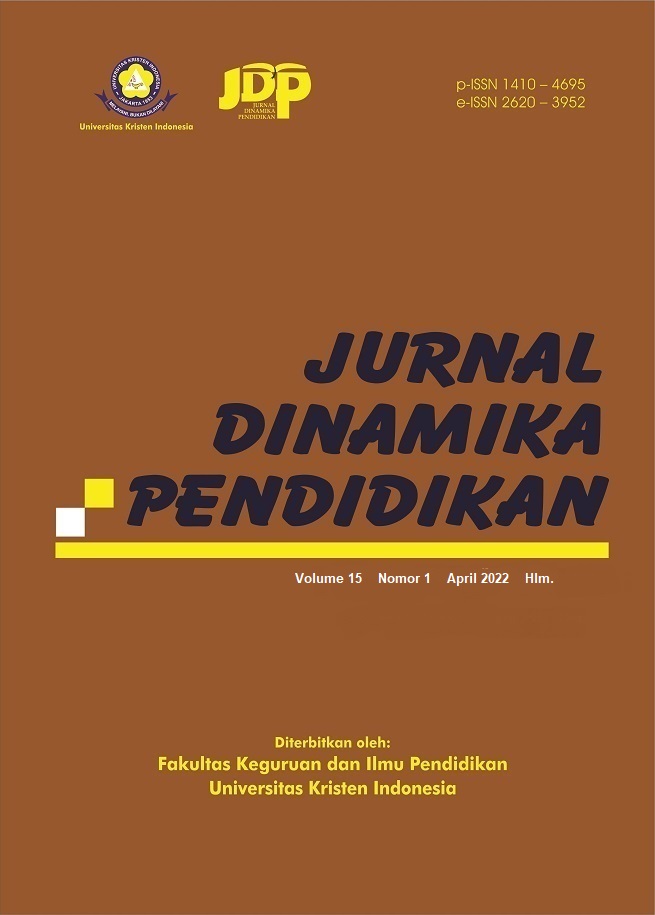Main Article Content
Abstract
This study describes the implementation of home visit tutoring activities as the student study service program, which then used as narrative research. This activity was held at Mi Unwanul Falah for English subjects in grade 6 elementary school. Based on the results of research showed that children will respond to lessons better if the procurement is carried out in an interesting and interactive way, such as the use of diverse and concrete learning media so as to improve the quality of children's learning during the COVID-19 pandemic
Keywords
homevisit
learning media
teaching english
Article Details

This work is licensed under a Creative Commons Attribution 4.0 International License.
How to Cite
Zaitun, Z., Hadi, M. S., & Aprilia, D. C. (2022). TEACHING ENGLISH DURING PANDEMIC COVID 19: HOME-VISITING STUDENTS AT MI UNWANUL FALAH: English. Jurnal Dinamika Pendidikan, 15(2), 125-131. https://doi.org/10.51212/jdp.v15i2.27
References
- Asyhar, Rayandra. 2012. Kreatif mengembangkan Media Pembelajaran. Jakarta: Referensi Jakarta.
- Bransford, J. D., Brown, A. L., & Cocking, R. R. (Eds.). (2000). How people learn: Brain, mind, experience, and school. Commission on Behavioral and Social Sciences and Education.
- Brown, H. D. (2001). Teaching by Principle: an Interactive Approach to Language Pedagogy. New York:Longman.
- Chase, S. E. (2005). Narrative Inquiry: Multiple Lenses, Approaches, Voices. In N. K. Denzin & Y. S. Lincoln (Eds.), The Sage handbook of qualitative research (pp. 651–679). Sage Publications Ltd.
- Daiute, C. & Lightfoot, C. (Eds.). (2004). Narrative Analysis. Studying the Development of Individuals in Society. Thousand Oaks, Sage Publications.
- Djamarah, Syaiful Bahr, dan Aswan Zain. (2013). Strategi Belajar Mengajar . Jakarta : PT Rineka Cipta.
- Harmer, J. (2007). The Practice of English Language Teaching (4th ed.). Cambridge: Pearson Education.
- Murniarti, Erni (2021). Analisis Kompetensi Pedagogik Guru pada Pembelajaran Daring dimasa Pandemi Covid-19. Jurnal of Education 4(3).
- Naz, A. A., & Akbar, R. A. (2010). Use of Media for Effective Intruction its Importance: Smoe Consideration. Journal of Elementary Education, 18(1-2), 35-40.
- Parlakian, R. (2010). Beyond Twinkle-Twinkle: using Music with Infants and Toodlers, Young Children. National association for the Education of Young Children. 65(2). 14-19.
- Puspitasari, D., Rahayu, W. W., Rohmatunnazilah, & Suwarno. (2020). Exploring the Feelings of International Students: When We Learn Virtually during the COVID-19 Pandemic. Journal of International Students, 10(S3), 142–160. https://doi.org/10.32674/jis.v10iS3.3204
- Singh, V. & Thurman, A. (2019). How many ways can we define online learning? A systematic literature review of definitions of online learning (1988-2018). American Journal of Distance Education, (33)4, 289- 306. https://doi.org/10.1080/08923647.2019.1663082.
- Schreiber, James & Asner-Self, Kimberly. (2011). Educational Research: The Interrelationship of Questions, Sampling, Design, and Analysis. Hoboken, NJ: John Wiley & Sons.
- Sudrajat, Akhmad. (2011). Mengatasi Masalah Siswa melalui Layanan Konseling Individual. Yogyakarta: Paramitra Publishing.
- Vernon, S. (2009). The benefits of using Games. Retrieved August 20th, 2020, http://www.englishgames.com
- Wright, A., Betteridge, D., & Buckby, M. (2005). Games for language learning (3rd ed.). New York: Cambridge University Press.
